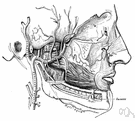The
maxillary artery contributes significantly to the cerebral arterial circle through the rete epidural mirabile while the basilar artery attached to the cerebral arterial circle where its blood flow directed caudally rather than rostrally (Kietyka-Kurc et al., 2015; Alsafy et al., 2017).
It requires embolisation of bilateral distal internal
maxillary artery and unilateral facial artery.
All local measures of packing failed to arrest the bleeding, and the patient underwent emergency angiography to identify and treat the possible source of bleeding, which was anticipated to be from the right internal
maxillary artery. However, the angiogram did not show any major source of bleeding in relation to the internal
maxillary artery, but identified a large DA of the extracranial part of the right ICA [Figure 2].
However, with this technique, the tip of the needle was in close proximity to the main trunk of
maxillary artery and pterygopalatine ganglion.
The power or color Doppler mode can be turned on to identify the sphenoid palatine artery, which is a branch of the
maxillary artery, flowing to the pterygoid palatine fossa.
Additionally, it has been shown that paraganglionic tissue exists around the terminal portion of the
maxillary artery in infants and could possibly represent a point of origin for paragangliomas in the nasal cavity due to its anatomic proximity [19, 45].
not only provide further evidence of reduced
maxillary artery blood flow when cats' mouths are opened wide, they also offer a simple strategy to reduce the risk of post-anesthetic blindness by using custom-made plastic gags ...
Reported advantages include easy availability of the flap, large blood supply (facial artery,
maxillary artery and superficial temporal artery) that the recipient bed receives, ease of mobility, minimum donor site morbidity, procedure simplicity, low complication rates and less time consuming, compared to other flap reconstruction procedures.5,6 When precisely dissected and mobilized, the pedicled buccal fat pad can be used in reconstruction of defects up to 10 x5.5x1.1 cm in size.7
The internal
maxillary artery (IMA) is the last terminal branch of the carotid artery.
Giant cell arteritis (temporal arteritis) causes jaw claudication due to involvement of branches of the external carotid artery, such as the ascending pharyngeal artery and internal
maxillary artery. Jaw claudication results in improper mastication and larger food boluses, with increased dysphagia.
 maxillary artery - either of two arteries branching from the external carotid artery and supplying structure of the face
maxillary artery - either of two arteries branching from the external carotid artery and supplying structure of the face